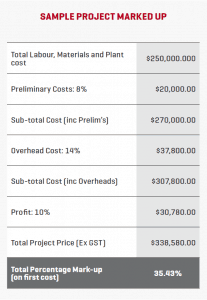The art of plumbing estimation
Misquoting clients can mean you are already on the backfoot before picking up a spanner. Having a consistent estimation procedure in place is just good business. Andy Farrell explains.
“I would prefer to pass on a project and lay on a beach somewhere, than to under quote the job and work myself bankrupt,” Andy says.
Estimating or quoting, is fundamental for any plumbing business to be successful in a service based business as potential clients will almost certainly request a quote from you prior to awarding a project. If the job has been priced correctly, then it is fair to say you’ll make a decent profit.
Get it wrong, and you may lose money and unfortunately, in some cases, much more. The competitive landscape of the plumbing industry has evolved over the past few decades. Clients and builders alike are highly motivated to reduce costs and seek value for money when building a project, sometimes accepting the lowest submitted price in order to achieve a set budget.
This practice can be to the detriment of the plumbing contractor. As the margins get tighter and projects become more fiercely contested, it becomes much harder to successfully
bid for a project.
In recent years, I have been invited to submit tenders for projects only to find out over 20 other plumbing companies are competing for the same contract. The chances of winning the contract are slim, and then to make a fair and reasonable profit becomes extremely concerning.
So, what’s the solution to reducing the risk of falling into the trap of under-quoting projects? Simple: be consistent and know your bottom line. Implementing a comprehensive estimating system that you have confidence in is vitally important, especially if you aim to achieve accurate quotes on a consistent basis.
Consistency can only be achieved through experience, practice and prolific record taking. It’s like anything else in life, ‘practice makes perfect’ and estimating is no exception. It is very important that you give careful consideration when deciding which method of pricing is suitable for your business.
Here are six key features a good system should include:
- Accuracy: have confidence in the submitted price
- Efficiency: the system should be quick to use
- User friendly: anyone with minimal plumbing and/or computer skills can use it
- Flexibility: can modify a rate to suit each project
- Good reporting: complete specific project break down
- Transparency: see how each cost has been calculated
There are a few different ways plumbers price a project, each have their advantages and disadvantages. The most common is educated guessing. This is when you look at the project and from past experiences of a similar job; you throw a number at it and wait for the builder to tell you if you are “on the money”.
Personally, this is a very cavalier form of quoting, as it’s impossible to know the projected profit margin. Another is per point pricing. This where the total number of fixtures (points) are tallied and multiplied by an amount resulting in the project price (eg. 150 points x $2,500.00 = $375,000.00).
These methods of pricing are quick and easy, but are thwart with danger as they don’t take into consideration the diff erent requirements of each project. The most accurate form of estimating is the ‘standard rate method’ as it creates a consistent benchmark for each individual component of the project.
The advantage is that each standard rate can be easily modified (if required) to suit the different site/project conditions. This type of pricing is quick, accurate, flexible and completely transparent.
How the standard rate method of quoting works
STEP 1: Measure a complete take-off for the project and enter the details/quantities into an estimating program. This will result in having the ‘first cost’ of the project, which is the cost to install all the required works (labour, materials, excavation and backfill).
STEP 2: Add the ‘preliminary costs’ of running the project (supervision, wet weather, fl oating equipment, etc). This is usually entered as a percentage (from my experience around 8% should cover the prelims).
STEP 3: Add your businesses ‘overhead cost’ (cost of running your business verses the turnover) and add it as a percentage. An average sized plumbing business may have an overhead cost of around 14%, but your accountant can give you this information. The total of the above (fi rst cost, preliminaries and overheads) is the absolute bottom line of the project.
STEP 4: The final and most important step of the entire process is to calculate and add the projected profit you wish to make on the project (for the sample below we are using a 10% profit margin). This is entered as a percentage, which will calculate the dollar amount of the expected profit.
Here is an example of a project mark-up breakdown:
From the above information, you now know what the project will cost you to complete (in the sample above, it is $307,800). Therefore, if the builder says that you can have the job for $300,000 you instantly know that you would lose a projected amount of $7800 if you take the project.
Alternatively, you may be happy to reduce the projected profit amount to secure the job and aim to negotiate better prices from your suppliers. This just gives you the confidence to know your bottom line and to walk away from an undervalued project.
It’s important that you have confidence in your pricing system and remember that practice makes perfect.

